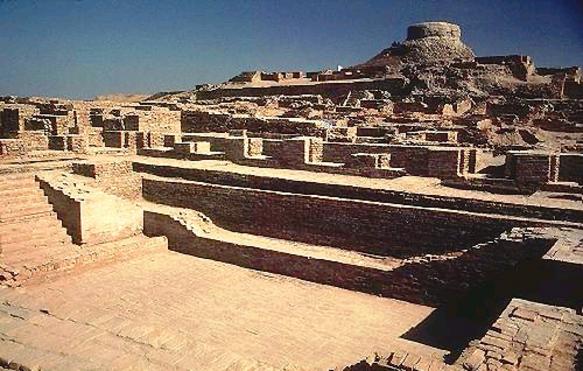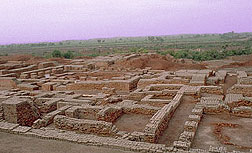The Indus Valley Civilization, situated in a resource-rich area, is notable for its early application of city planning and sanitation technologies. Cites in the Indus Valley offer some of the first examples of closed gutters, public baths, and communal granaries. The Takshashila University was an important seat of learning in the ancient world. It was the center of education for scholars from all over Asia. Many Greek, Persian and Chinese students studied here under great scholars including Kautilya, Panini, Jivaka, and Vishnu Sharma.
Excavated ruins of Mohenjo-daro, Pakistan.
Ancient India was also at the forefront of seafaring technology - a panel found at Mohenjodaro, depicts a sailing craft. Ship construction is vividly described in the Yukti Kalpa Taru, an ancient Indian text on Shipbuilding. The Yukti Kalpa Taru, compiled by Bhoja Narapati is concerned with shipbuilding. (The Yukti Kalpa Taru had been translated and published by Prof. Aufrecht in his 'Catalogue of Sanskrit Manuscripts').
Indian construction and architecture, called 'Vaastu Shastra', suggests a thorough understanding or materials engineering, hydrology, and sanitation. Ancient Indian culture was also pioneering in its use of vegetable dyes, cultivating plants including indigo and cinnabar. Many of the dyes were used in art and sculpture. The use of perfumes demonstrates some knowledge of chemistry, particularly distillation and purification processes.

(EXCAVATED RUINS OF MOHENJADARO)
TOWN PLANNING SKILLS IN ANCIENT INDIA
If by 'urban' we mean the tendency to form society, founding cities with all their attendant rules, then the Harappan people succeeded admirably. Excavations show a degree of urban planning which the Romans achieved only later, after a gap of 2500 years.
The twin cities of Mohenjo-daro and Harappa formed the hub of the civilization. They are representative in the sense that planning principles employed here are followed practically without change at all other sites. Both cities were a mile square, with defensive outer walls. An orthogonal street layout was oriented toward the cardinal directions. The street layout shows an understanding of the basic principles of traffic, with rounded corners to allow the turning of carts easily. These streets divided the city into 12 blocks. Except for the west-central blocks, the basic unit of city planning was the individual house.
The Harappan house is an amazing example of a native people, without the benefit of technology, adapting to local conditions and intuitively producing an architecture eminently suited to the climate. The house was planned as a series of rooms opening on to a central courtyard. This courtyard served the multiple functions of lighting the rooms, acting as a heat absorber in summer and radiator in winter, as well as providing an open space inside for community activities. There were no openings toward the main street, thus ensuring privacy for the residents. In fact, the only openings in the houses are rather small - this prevented the hot summer sun heating the insides of the houses.

(DHOLAVIRA-EXAMPLE OF TOWN PLANNING)
The ancient Indian towns were all beautiful with well planned cities. 5000 years ago, Indian towns flourished with majesty and grandeur.
Ancient India was characterised by Broad roadways, streets running from North to South or East to West, with
- Well-planned sectors of residential zones

- Underground drainage systems
An advanced drainage system is also in evidence. Drains started from the bathrooms of the houses and joined the main sewer in the street, which was covered by brick slabs or corbelled brick arches, depending on its width.

- Centrally located temple square
are some typical examples of Indian style of town planning.
KUSHINAGAR
Kushinagar was the city of 9th century B.C. Buildings of this city had cylindrical structures erected on top. they stand today to the astonishment of the world.

(RUINS OF KUSHINAGAR)
Great Bath
The city of Mohenjo-Daro possessed an amazing structure known as the Great Bath. The entire structure is about 179 feet long and 107 feet wide. The complex has a large on all sides. In the center of this quadrangle there is a large swimming enclosure that is 39 feet long, 23 feet wide and 8 feet deep. The entire complex is connected to an elaborate water supply and sewer system. The Great Bath was probably used for religious or ritualistic purposes.
It is unfortunate that none of the structures of the Indus Valley civilization survive intact today. Unlike Egypt and Mesopotamia, the Harappan people left nothing monumental, like the pyramids or ziggurats, for posterity to marvel at. This may be the reason that among the majority of books on architecture, the Harappan Culture hardly merits a note. However, the planning principles and response of the architecture to climate are a lesson to us all.

(THE GREAT BATH)
IN TEXTS
Valmiki Ramayana describes three cities namely
- Ayodhya
- Kishkinda and
- Lanka
They are described to have multistoried buildings, broad roads, Industrial zones and business clusters.

(DEPICTING AYODHYA'S SKILLED ARCHITECTURE)
Every book of Indian literature describes the city and its civilization related to the context before getting into the main theme of the book. The splendour of cities described in these books only reflects the advanced urban civilization of ancient India.
Many technical texts like VAASTU SASTRA in sanskrit describe the methods of planning and building towns and cities.
'Sukraniti', Or 'Sukracharya's Systems Of Morals'
-The translated work commanded so much attention of the scholars from around the world that an Introduction to this work had to be made into a separate work for a wider circulation, and which came to be known as “The Positive Background of Hindu Sociology” and contained a discussion on the date and the locale of the treatise.
This book describes how to construct roads and gives the ratio of products that are used in limestone mixture applied on the roads. The roads of ancient India appeared as strong and smooth as tortoise shell.
Many notes about the rules of construction are found in
- Kautilya's 'Artha Sastra'
- Viswa Karma's 'Vaastu Sastra'
- Kapila vatsyana's 'Mayamatyam'(-Kalamula Sastram)
CONCLUSION
The Indian skill of town planning and building construction can be said to be really talented. Indian brains have formulated rules for the proper town planning in a time which was very earlier when the other civilizations weren't able to establish such an excellent planning. This gives the talent and skill of Indians in BUILDING TECHNOLOGY.







No comments:
Post a Comment